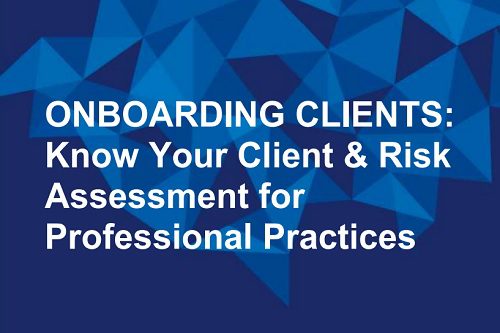Why professional service firms should focus on their onboarding processes

Authored by QBE Senior Risk Manager Calum MacLean
While disputes or claims can arise at a variety of points in a business relationship or professional engagement, the single most important point of risk control occurs before you even start working with a client.
Your risk assessment and onboarding processes can determine the level of risk, which clients are taken on, and what work your firm undertakes for those clients. Get that right, and you are setting a strong foundation for your business to grow well, for the long term.
For professional service firms, such as those in the legal, financial, administrative, marketing and consultancy sectors, the stock in trade is advising your clients – often on complex or high value matters. Every profession has types of work that are higher and lower risk, and while it’s not an exact science, there is usually a fairly well-established rule-of-thumb about that hierarchy of risk. As a starting point, you should be able to say what the risk appetite of your firm is.
Risk appetite
Your risk appetite is likely to change over time as the firm evolves and the market changes around it, so should be revisited annually, or more often as required.
Frameworks should be regularly shared and communicated. A key starting point would be to simply document your work-type risk appetite and share it across the firm, which reinforces important messaging and makes it more likely to be engrained in the way the firm operates. Better still, use this framework as a tool by building it into your work acceptance processes and your marketing strategy.
Know your client
It’s vital that you take time to properly verify and ‘know your client’ (KYC). If there is a single person in the firm through whom all potential new instructions must pass to be approved, the process may not need to be very involved at all, but it is still highly advisable that a record is kept evidencing the due diligence undertaken and the factors considered in making the determination. From a business insurer point of view, it is very reassuring when a firm can ‘show its workings’ in this manner.
If the decision to approve a client or matter is delegated further down the chain to a wider number of people, the process needs to be more evolved and formalised. You should undertake a written risk assessment on each new client and each new instruction.
All too often, firms think of risk assessment only in terms of client identity verification or anti-money-laundering, but they both offer too narrow a view of risk. Client and matter risks go far beyond many conventional ‘know your client’ checks.
Anti-money laundering
Since the 2017 Money Laundering, Terrorist Financing and Transfer of Fund (Information on the Payer) Regulations came into force, all UK-based professional firms have been required to ‘identify and assess the risks of money laundering and terrorist financing to which the business is subject’.
Having a business-wide anti-money laundering (AML) risk assessment is very useful, but, on its own it is quite a narrow assessment of risk, which is why we recommend that businesses have a risk appetite framework in place.
As part of your strategic decision-making, you should be considering, and documenting:
The broad areas of work in which you wish the business to operate, alongside an assessment of the respective risk/reward profile of each area of workThe work sub-types (within each broad area identified above) that are within and outside your appetiteThe skillset and experience of your existing fee earners and supervisors in relation to your target work types
Red flags
Knowing and understanding the nature of your potential client and their instruction better can be invaluable in spotting potential ‘red flags’ at the outset, which may mean you decide not to take the matter on, or if you do, that you do so with the right protections in place. This will also help you with accurate scoping and pricing, as well as helping ensure that you allocate the right staff to it from the outset.
Download our free guidance
QBE helps businesses build resilience through risk management and insurance.
Depending upon the size and complexity of the business needs, QBE customers can access a wide range of risk management services, self-assessment questionnaires and risk management toolkits which are focused on the key causes of claims, and on generating action plans for improved outcomes – including protecting employees, reducing risk and making claims less likely.
Our latest guidance, Onboarding Clients: Know Your Client & Risk Assessment for Professional Practices, can help you to structure and implement an effective client onboarding risk strategy, with links to relevant templates to help you implement these processes effectively.





